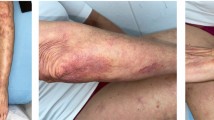Abstract
A 3-year-old boy of German descent suffered from two episodes of Streptococcus pneumoniae meningitis within 2 months. One month previously, the first skin lesion of Kaposi sarcoma (KS) had been observed behind his right ear. During the following 2 years KS disseminated not only mucocutaneously but also to visceral organs. Immunological evaluation revealed severe lymphocytopenia with reduced helper/suppressor T-cell ratio and impaired humoral immune response to pneumococci. Extensive laboratory tests gave no evidence for known immunocompromising infections. However, recently described DNA sequences from a Kaposi sarcoma-associated herpesvirus (KSHV) could be identified within skin tissue. As chemotherapy failed to stop tumour progression the patient was referred for bone marrow transplantation. Eighteen months later the KS is in remission and the patient in a good general condition.
Conclusion The case supports the hypothesis that KSHV is involved in the aetiology of KS. Bone marrow transplantation is possibly a therapeutic option for KS in patients with immunodeficiency not related to human immunodeficiency virus infection.
Similar content being viewed by others
Author information
Authors and Affiliations
Additional information
Received: 1 August 1996 / Accepted: 15 December 1996
Rights and permissions
About this article
Cite this article
Kusenbach, G., Rübben, A., Schneider, E. et al. Herpes virus (KSHV) associated kaposi sarcoma in a 3-year-old child with non-HIV-induced immunodeficiency. Eur J Pediatr 156, 440–443 (1997). https://doi.org/10.1007/s004310050633
Issue Date:
DOI: https://doi.org/10.1007/s004310050633




